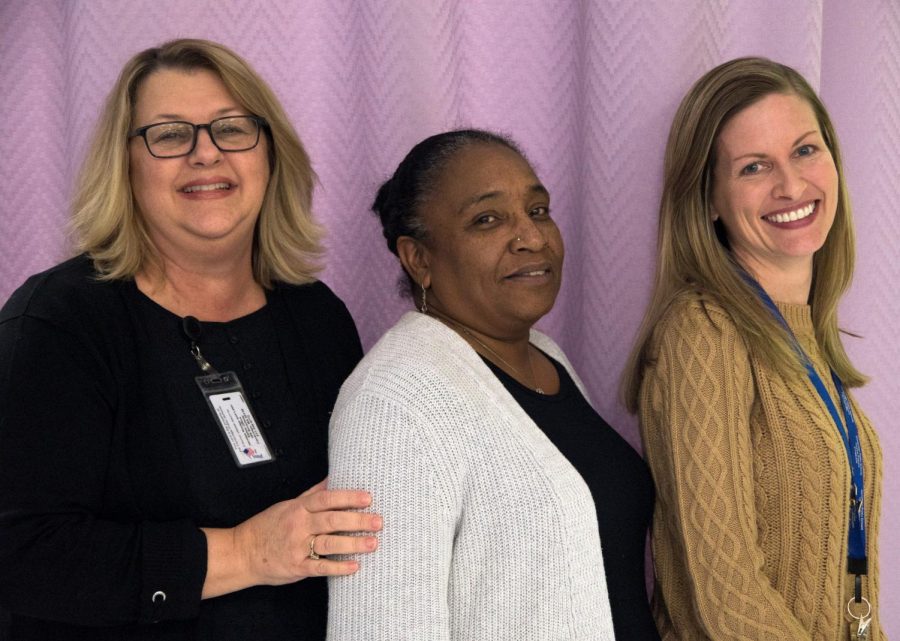Behind the Scenes: RSTA’s Health Assisting Program
The Health Assisting class is taught by Gina Hughes, Mechille Venus, and Kristian McLean.
February 1, 2019
Located along a hallway near the back entrance of the Main Cafeteria lies a spacious classroom filled with neatly organized medical supplies and a few hospital beds. This is the Health Assisting class, a Rindge School of Technical Arts (RSTA) program comprised of four levels and taught by Gina Hughes, Kristian McLean, and Mechille Venus. Typically by senior year, students who have been enrolled in Health Assisting throughout high school will be able to work with patients in real hospitals around Cambridge, instead of the mannequins they practiced on in the beginning.
While in the past, a student’s initial exposure to Health Assisting would be through RSTA’s exploratory program, students now must enroll in Introduction to Health Assisting, which is taught by Ms. Venus. Ms. Hughes explains that “part of the first semester is with Health Assisting and part is with [Early Education and Care].”
After completing Introduction to Health Assisting, students move onto Level One Health Assisting, also taught by Ms. Venus, which focuses on the healthcare system as a whole, as well as careers in the field. Reflecting on Level One, Ms. Venus says, “I just enjoy sharing my knowledge with [my students] and giving them the opportunity to see what the healthcare field has to offer them [and] … how much of a broad range it is.”
After Level One, students who decide to continue with the program take Level Two Health Assisting with Ms. McLean, which, Ms. Hughes explains, covers “the human body, illnesses, how to care for a patient, more in-depth anatomy, and actual hands-on [activities].” At the end of the year, students take the CNA, or Certified Nursing Assistant test, in order to move onto Level Three. For the past five years, the program has boasted a 100% passing rate for the CNA. The CNA is one of the certifications that Health Assisting students can obtain throughout the course of the program, along with CPR and First Aid.
The final level of Health Assisting is Level Three, taught by Ms. Hughes, where students go to clinical and work paid positions starting at 7:30 AM at Mount Auburn and Spaulding Hospital. There, students are accompanied by Ms. Hughes and take care of patients using the knowledge that they have gathered throughout their time in the program. After clinical, Level Three Health Assisting students return to CRLS at 10:30 AM, eat lunch, and attend their more traditional academic classes.
Health Assisting is an amazing opportunity for students interested in the medical field according to students such as Crystal Delloiacono ’19, who is in Level Three Health Assisting. “Once I heard about Health Assisting, I knew it was the fastest way into the healthcare field and would give me a major head start.” After completing the program, students are well-equipped to continue as a health assistant or to seek another career in healthcare.
Level Three Health Assisting student Kayla Furtado ’19 explains that the program teaches “life skills” and “can prepare you for your future endeavors … in the medical field of your choosing.” Oftentimes, people assume that all Health Assisting students either remain as health assistants or move on to become registered nurses after high school. However, Ms. Hughes debunks this misconception, estimating that about 25% of the time, students choose a different path, becoming an emergency medical technician, physician, physical therapist, or pursuing the public policy side of the medical field. Ms. McLean views Health Assisting as the first step to a student’s long and successful career in the medical field, saying, “This is really step one in what I hope is a big long staircase—who knows what’s at the top.”
Aside from the academic aspects, the program is also a tight-knit and motivational community. Senior Abigel Ayele explains, “As the years go by, our group gets closer, and being with a group of people that have similar goals as you is really fun and nice to be a part of.” Ms. Hughes, Ms. McLean, and Ms. Venus all agree that this aspect of teaching Health Assisting is extremely rewarding, allowing them to form real connections with their students.
Delloiacono agrees, saying that one of the best parts of the program is “building great relationships with the teachers and other students over the years. [It’s] very much worth all the hard work.”
This piece also appears in our January 2019 print edition.










